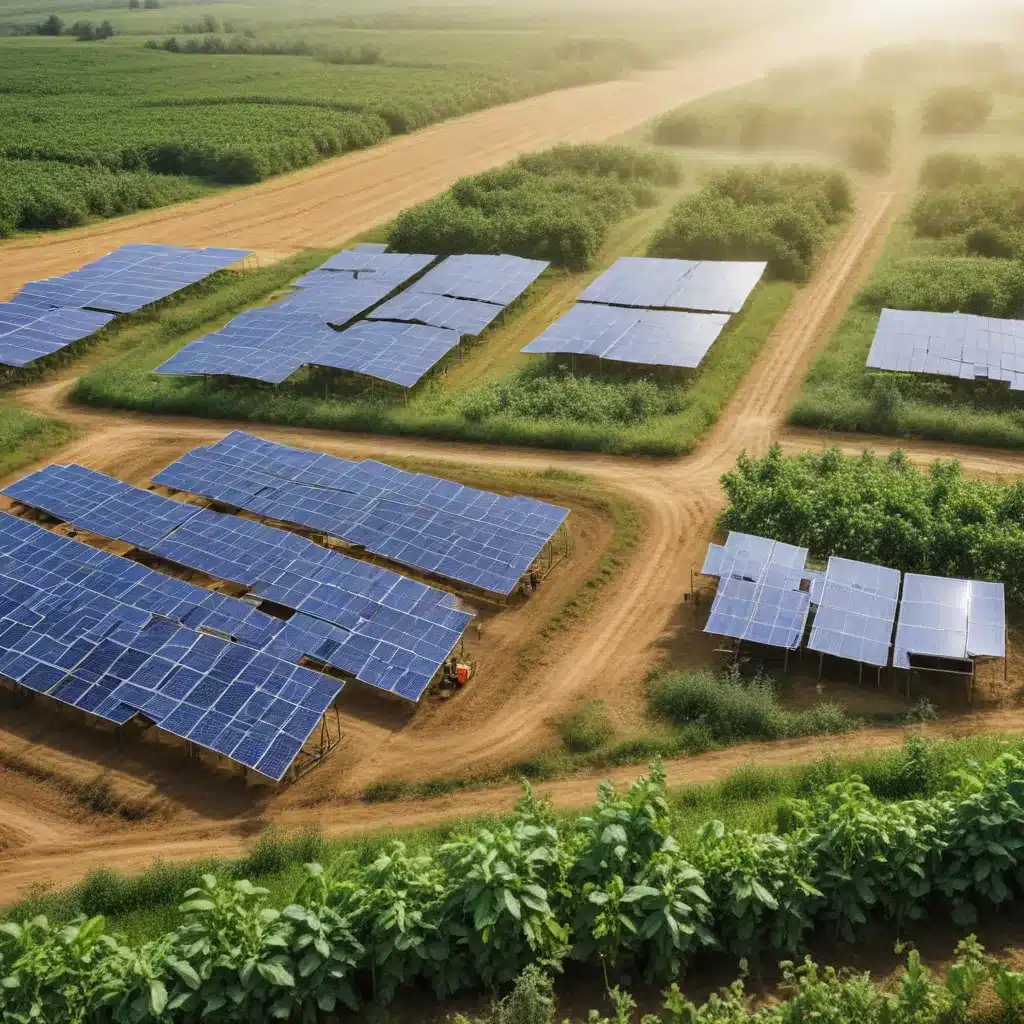
Renewable Energy and Sustainable Agriculture: Powering the Food System
As the European Union accelerates its transition to clean energy, the intersection of renewable power and sustainable agriculture is becoming increasingly crucial. Across the continent, innovative projects are harnessing the potential of solar, wind, and biofuels to decarbonize the food system, while circular economy principles are transforming food production, processing, and waste management.
Solar Energy Applications
Solar photovoltaic (PV) technology has emerged as a versatile solution for powering agricultural operations. From solar-powered irrigation pumps to off-grid refrigeration systems, the falling costs and improving efficiencies of solar PV are making it an increasingly attractive option for farmers. In Spain, for instance, the government’s net-metering scheme has incentivized the installation of rooftop solar arrays on agricultural facilities, allowing farmers to offset their energy bills and sell surplus electricity back to the grid.
Similarly, in the Netherlands, innovative agrivoltaic systems are being deployed, where solar panels are integrated directly into farmland, providing shade for crops while generating renewable energy. This symbiotic approach not only boosts agricultural productivity but also maximizes land-use efficiency, a crucial consideration in the densely populated European landscape.
Wind Power Integration
The continent’s abundant wind resources are also being harnessed to power agricultural operations. In Denmark, for example, several wind farms have been strategically located near major food processing facilities, enabling power purchase agreements (PPAs) that directly supply renewable electricity to these energy-intensive industries. This model not only reduces the carbon footprint of food processing but also provides farmers and cooperatives with a stable, long-term energy source.
Furthermore, the integration of wind turbines into agricultural landscapes is gaining traction. In Germany, small-scale community wind projects are enabling farmers to collectively invest in and benefit from local wind power generation, strengthening the resilience of rural communities.
Biofuel Production
The production of biofuels from agricultural waste and dedicated energy crops is another area where Europe is making strides. In France, new biorefineries are converting crop residues and animal manure into advanced biofuels, providing farmers with an additional revenue stream while reducing the reliance on fossil fuels in the transportation sector.
These biofuel initiatives are complemented by the growing adoption of precision agriculture practices, which optimize the use of inputs like fertilizers and pesticides. By reducing the carbon intensity of food production, these technological advancements are helping to create a more sustainable agricultural ecosystem.
Organic Farming Methods
Beyond the energy sector, sustainable agriculture practices are also gaining traction across Europe. The rise of organic farming is a prime example, with an increasing number of farmers transitioning to chemical-free cultivation methods that prioritize soil health and biodiversity. In Italy, the government’s “Organic Districts” initiative has spurred the development of localized organic food networks, enhancing food security and reducing the environmental impact of the food system.
Water Conservation Strategies
Water scarcity is another pressing challenge faced by European agriculture, particularly in the Mediterranean region. Innovative precision irrigation systems, powered by renewable energy, are helping farmers optimize water usage and reduce waste. In Spain, for instance, the integration of Internet of Things (IoT) sensors and machine learning algorithms into irrigation infrastructure has enabled more precise, data-driven water management.
Soil Health Management
Healthy, resilient soils are the foundation of sustainable agriculture, and European farmers are embracing practices that enhance soil fertility and carbon sequestration. Agroforestry systems, which integrate trees and shrubs into croplands and pastures, are gaining traction, as they improve soil structure, increase biodiversity, and provide additional revenue streams from timber and non-timber forest products.
Renewable-Powered Food Processing
The decarbonization of food processing is another critical aspect of the transition to a sustainable food system. In Ireland, for example, wind-powered dairy processing facilities are reducing the industry’s reliance on fossil fuels, while in Sweden, biogas-fueled combined heat and power (CHP) plants are providing renewable energy to food manufacturers.
Waste-to-Energy Conversion
The valorization of food waste and agricultural residues is also on the rise, with innovative waste-to-energy technologies transforming these materials into biofuels, biogas, and other valuable products. In the Netherlands, the Brightlands Chemelot Campus is pioneering the conversion of vegetable, fruit, and garden waste into bioplastics, showcasing the potential of a truly circular food economy.
Cold Chain Optimization
Improving the energy efficiency of the food cold chain is another key focus area. Across Europe, solar-powered and grid-integrated refrigeration systems are being deployed to reduce the reliance on energy-intensive conventional cooling technologies, especially in regions with limited access to reliable electricity.
Closed-Loop Nutrient Cycling
The concept of a closed-loop food system, where nutrients are continuously recycled, is gaining traction in Europe. In the Netherlands, for instance, the “Nutrient Recovery and Reuse” initiative is pioneering the use of anaerobic digestion and struvite precipitation to recover phosphorus and nitrogen from agricultural waste, reducing the need for energy-intensive synthetic fertilizers.
Food Waste Valorization
Across the continent, urban agriculture initiatives are also playing a vital role in sustainable food systems. In Paris, for example, the “Parisculteurs” program has transformed rooftops, walls, and other underutilized urban spaces into productive gardens, reducing food miles and food waste while enhancing community engagement.
The European Union’s ambitious Green Deal and Farm to Fork strategies have provided a robust policy framework to accelerate the integration of renewable energy and sustainable practices into the food system. Through targeted investments, innovative financing mechanisms, and collaborative public-private partnerships, the region is poised to lead the global transition towards a more resilient, low-carbon, and equitable food future.
As the European Future Energy Forum gathers industry leaders, policymakers, and green energy advocates, the synergies between renewable power and sustainable agriculture will undoubtedly be a central focus. By harnessing the transformative potential of clean energy solutions, Europe can unlock new levels of agricultural productivity, enhance food security, and contribute to the global fight against climate change.






